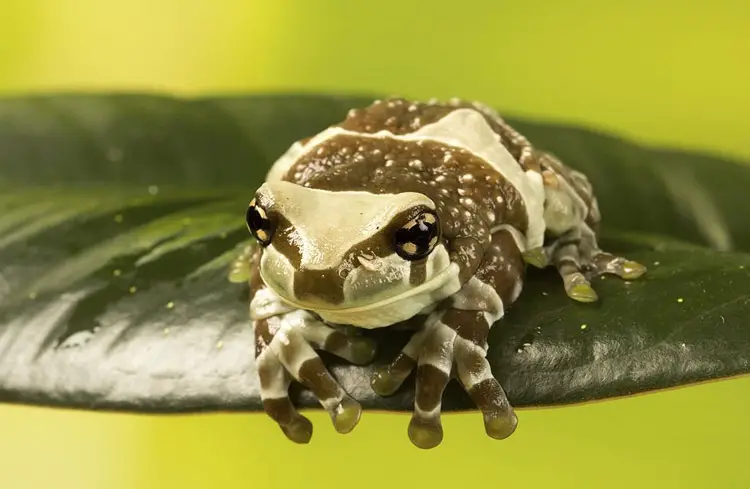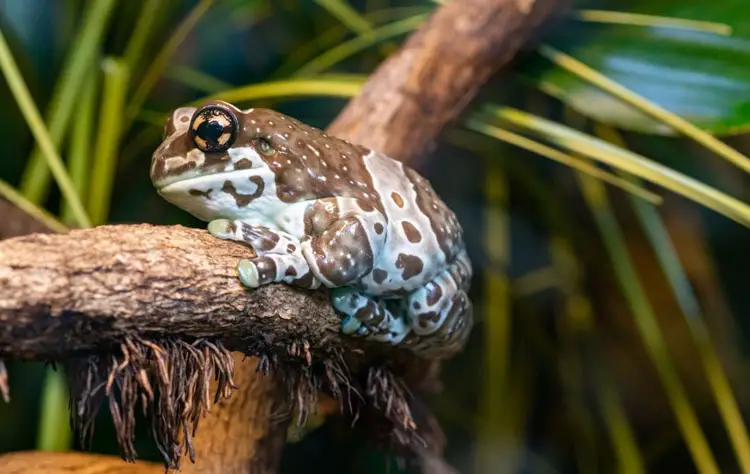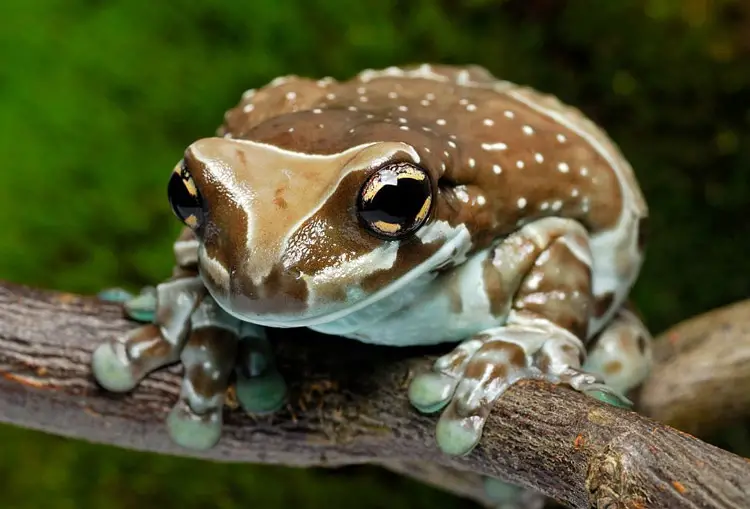Amazon milk frogs are one of the larger species of frogs that are kept in captivity. They are hardy and easy to find. Many of the available frogs are bred in captivity, so they are inexpensive and adapt easily.
Despite this, we’d probably avoid recommending them for new keepers. They have similar care to other frog species but require a higher humidity level and specific settings within the tank that can be difficult for inexperienced keepers to achieve.
| Common Name | Amazon Milk Frog |
| Scientific Name | Trachycephalus resinifictrix |
| Natural Habitat | Amazon rainforest |
| Adult Size | 3 – 3 ½ inches |
| Lifespan | 15 to 25 years |
| Diet | Carnivores |
| Experience Level | Intermediate |
| Enclosure Size | 20-gallon |
However, today’s question isn’t whether or not they are good for beginners. The question is, instead, how to care for Amazon milk frogs — and here’s a helpful guide!
Overview
The Amazon milk frog (Trachycephalus resinifictrix) is a large-bodied species of tropical frog. Hailing from the depths of the Amazon rainforest, these frogs are known for their unique color pattern and how easy they are to handle as captive-bred adults.
They require high humidity levels, moderate temperature, and enough vertical space to move and explore as they are an incredibly active species. Amazon frogs are non-toxic, and docile in temperament. Like most amphibians and reptiles, Amazon milk frogs are nocturnal, preferring to do their hunting and exploring under the cover of darkness.
Adult Amazon milk frogs reach sizes of up to 4 inches, with sex playing a large part in how big they grow. Females are larger than males.
The species is carnivorous and has a voracious appetite that pairs perfectly with its large stature and bold personality.
Enclosure
Size
If you’re housing one or two adult Amazon milk frogs, a standard 20-gallon aquarium/terrarium will do the trick. Juveniles can be successfully housed in 10-gallon enclosures for easy monitoring.
However, the more space you can provide your frogs with, the better. Amazon milk frogs like vertical space, as they are fond of climbing in tree branches and on logs, so if you can, opt to provide them with an enclosure that offers more vertical than horizontal space.
If you have a group of 3 or more adults, you’ll need to provide a larger-sized aquarium, to begin with — a 40-gallon would be a good start.
Exo Terra Glass Terrarium Tank – 24 x 18 x 18 Inches
Temperature
Amazon milk frogs require a near-constant air temperature of around 75 degrees. This temperature should be maintained on one side of the enclosure, allowing the other end to be cooler and creating a gradual temperature gradient.
VIVOSUN Reptile Heat Mat with Digital Thermostat
This is best achieved by using a single heat source that is placed on one end of the enclosure. This heat source can come in the form of a heat bulb or ceramic heat emitter, heat tape, a heat panel, or a heating pad.
Lighting

In their natural habitats, Amazon milk frogs receive a good amount of UVB light from the sun. This being said, they require a UV light source in their enclosure, too.
UVB lighting should be used during the day and turned off at night and doesn’t have to be very high wattage to be effective.
Keep in mind, though, that mesh aquarium tops will block some of the UV rays that could be absorbed by your frog’s skin. You may need to use a slightly higher-wattage bulb if your lid is particularly thick or dark.
Humidity
Amazon milk frogs require moderate to high levels of humidity. Ideally, their enclosures’ humidity should sit between 70 and 90%, with the occasional spike that mimics the way their natural environment changes.
You can mist your frog’s enclosure 1-2 times per day to help maintain the humidity levels. You might also consider installing an automatic misting system that will mist the enclosure at specific intervals throughout the day and night.
In addition, providing a large water bowl on the warm side of the enclosure will help keep humidity levels up as the water evaporates into the air.
All water that is used should be dechlorinated and treated for chemicals before being used in the enclosure, whether for misting or for the water bowl.
Enrichment
In terms of decor, Amazon milk frogs require a clean substrate that retains moisture easily. Damp paper towels and sphagnum moss work well for this species, as does damp coco choir and Eco Earth.
Galápagos Terrarium Sphagnum Moss
While the frogs don’t necessarily need a substrate to stay healthy, most keepers choose to use a naturalistic option to make the terrarium look appealing, as well as to help boost humidity levels within the enclosure.
These frogs rarely spend time on the ground, so most of your decor effort should be focused on the upper portions of the enclosure. Get creative (and don’t be shy) with branches, vines, cork bark, PVC pipe, bamboo, and other structures that are ideal for climbing.

You may also choose to utilize live plants, just be aware that the frogs are quite heavy and may squish and kill live plants without much thought. Artificial plants work well for this species, as they are incredibly durable and can withstand their weight without being permanently ruined.
In their natural habitat, Amazon milk frogs spend a lot of their free time in pools of rain that have collected in hollow stumps and holes in the ground, so providing your frogs with a feature that mimics this is always going to be appreciated.
Diet
Amazon milk frogs are carnivorous, living off a diet of live prey items. Good food items for your frog can include:
- Crickets
- Wax worms
- Cockroaches
- Earthworms
- House flies
Your frog’s diet should be varied and fatty food items such as wax worms should be fed only on occasion as they can lead to obesity. The staple of your frog’s diet should be crickets of the appropriate size for your individual frog. Juveniles will do best with smaller crickets, 1-2 weeks in size, while older crickets will be ideal for larger and adult-sized frogs.
Every few feedings, the crickets should be dusted with a calcium powder. This can be done by either dipping the crickets into the container of calcium powder or by dusting them with the powder and shaking them around inside of a bag or container.
Alternatively, you could also offer your frog a multivitamin.
Zoo Med Calcium With Vitamin D3 Reptile Food
Adult Amazon milk frogs can be offered pinky mice on occasion. However, this is purely optional and the frogs don’t need mice to survive.
In addition to a variety of food, your frog should also have access to clean, dechlorinated water to prevent dehydration.
Behavior/Temperament and Handling
Amazon milk frogs thrive in groups of 3-5 individuals. Typically, mixed groups of males and females do well together. Sometimes, males will harass the females of the group for mating purposes but for the most part, they all get along well.
These frogs are nocturnal and will sleep most of the day, partaking in exploring and climbing during the nighttime hours. During the day, they will spend much of their time hiding and resting but can be woken up if you mist their enclosure or offer them food.
In terms of handling, Amazon milk frogs can be handled relatively easily as adults. Juveniles, however, are fragile and should only be handled when absolutely necessary.
Once your frogs are 2” in size, they can be handled more regularly. Just be sure to wash your hands thoroughly before touching them, as the oils and germs on your skin can be harmful to their immune systems and skin. In addition, it’s beneficial to your frogs to have your hands be damp when handling them.

Breeding
In nature, the Amazon milk frog breeds almost exclusively in tree holes. The holes that are used face upward and are filled with rainwater. The males sit inside the holes and call to attract potential female mates. If they’re lucky, a female answers their call and the pair engages in the mating process.
The female lays her eggs on the surface of the water inside the hole. Within a day, the eggs will hatch into tadpoles.
In captivity, on the other hand, breeding occurs when both the male and female frogs are healthy and well-fed. In addition, breeders must provide a water-filled hole for the pair to procreate in. Many breeders recommend cycling the frog through a rainy season using a rain chamber, while others see no difference in breeding success regardless of temperature, humidity, or whether or not a rain chamber is used.
If you’re interested in breeding your Amazon milk frogs, it’s important to remember that hundreds of tadpoles can be born from one successful pairing. Because of this, you must have a care plan in place and ensure that you have the means to care for so many frogs. A care plan should include ensuring that you have enough terrariums for them to live in, as well as an adequate food supply, and the appropriate heat sources and lighting.
Lifespan
In the wild, Amazon milk frogs live for an average estimated 15 years. In captivity and with adequate care, they can live for up to 25 years. The difference in lifespan comes down to the trials and tribulations that wild frogs go through, including temperature, habitat fluctuations, and predators.
To maximize the length of your frog’s life, provide them with the best care possible.
Potential Health Issues
Parasitic and Fungal Infections
Amphibians, like reptiles, are incredibly prone to both parasitic and fungal infections. Fungal infections show up as physical blemishes on the skin, typically as dark gray to light-tan-colored nodules and spots.
Symptoms of fungal infections can include lethargy, discoloration, and abnormal behavior.
Parasitic infections, on the other hand, show up internally. They are observed by human eyes when they make their way out of the frog’s body via feces.
Symptoms include lethargy, loss of appetite, and live or dead parasites (worms) in the feces.
Hypo and Hyperthermia
Hypothermia occurs when your frog’s habitat is too cold. Hyperthermia is the opposite, occurring when the temperature is too warm for a long period of time. Both cases can be deadly to your frog.
The symptoms of hypothermia include weakness, dehydration, less movement, and rapid breathing and panting.
The symptoms of hyperthermia include cold skin, refusing food, a stiff body, eyes that appear sunken, wrinkling skin, and unresponsiveness.
Metabolic Bone Disease
Metabolic bone disease (MBD) is common in both reptiles and amphibians. Caused by a deficiency of vitamin D, calcium, and phosphorus, MBD leaves your frog’s bones brittle and susceptible to damage.
MBD can be managed and prevented through the use of calcium supplements, multivitamins, and UVB light.
Symptoms include leg abnormalities, defecating issues, spinal aberrations, a reluctance to move, bone fractures, and anorexia.
Obesity
Obesity for frogs is the same as it is for humans. It is the result of eating too many fatty foods or more than is necessary at feeding time. Fatty foods such as wax worms should only be given on occasion for this very reason — frogs love them but they’re easy to eat too many of.
The most prominent symptom of obesity is when your frog looks round or thick around the middle.
Conclusion
Amazon milk frogs are amazing creatures with active personalities and plenty of appeal. They are easy to care for – save for the particular situation and care they require for breeding – and readily available from breeders.
They thrive in groups, are accustomed to handling, and make great observational pets for owners who operate on a schedule that has them staying up late or waking up early.
Interested on other frogs? Check also:







